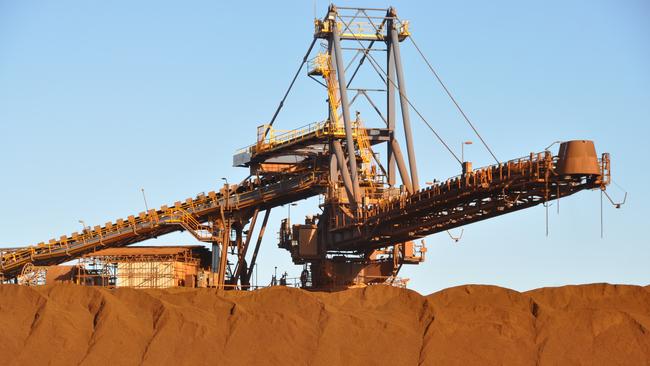Fortescue cuts interim dividend as profit drops 32pc; Andrew Forrest to bank $973m dividend
Andrew Forrest’s Fortescue says there’s no need to review its culture, after a string of executive departures.

Outgoing Fortescue Metals Group chief executive Elizabeth Gaines says she sees no need for a review of the company’s culture after the wave of executive departures over the last year, saying the exodus is a sign of progression and succession at the mining major.
Despite delivering another strong half-year financial result, Ms Gaines again faced pressure from analysts on the company’s earnings call over the massive change of direction at the iron ore miner, as it looks to build a new business as a green energy giant.
Fortescue will pay an 86c a share dividend after booking a $US2.78bn half-year profit.
Although that is down almost a third on its result this time in 2021, as discounting on its iron ore hit the company’s bottom line, Ms Gaines said it is still the third best half-year result in the company’s history.
While also well down on last year’s $1.47 interim dividend, the half-year shareholder payout is still worth about $973m to Fortescue founder and chairman Andrew Forrest.
But while Fortescue’s operations are still performing strongly, delivering record iron ore volumes in the market in the first half of the financial year, the company has faced a wave of executive departures over the last year.
Including the recent resignations of Ms Gaines and corporate affairs director Alison Terry, Fortescue has now lost more than half of its 11-member executive leadership team over the past 12 months.
It has also lost senior operational managers from its iron ore operations – partly linked to the Fortescue board’s decision to cap share rewards linked to the company’s share price performance – and senior staff at its green energy subsidiary Fortescue Future Industries.
Asked by analysts whether the departures were a sign the company needed to review its corporate culture, Ms Gaines said the resignations had allowed Fortescue to promote new talent from within the company, as well as recruit quality appointments from outside of the company.
“The majority of the turnover we are seeing are people who have been with us for more than a decade. I think the longevity we’ve had of people in the executive team is actually unusual, and that’s a testament to the strength of the culture at Fortescue,” she said.
“What I’m really pleased with is that we’ve brought in a combination of external talent as well as seeing some really good succession as a result of those movements. We’ve seen some great talent, we’ve seen progression, we’ve seen succession and I’m really pleased with the composition of our executive and leadership team, so we don’t need a review.”
The iron ore major booked revenue of $US8.13bn for the half, down 13 per cent on the first half of the previous financial year, but earnings before interest, tax, depreciation and amortisation fell 28 per cent to $US4.76bn.
Fortescue shipped a record 93.1 million tonnes of ore in the half, with its half-year shipments up 3 per cent compared to the back half of 2020.
But its earnings were hit by steeper discounts applied to the lower grade ore it sells to steel mills, with the price Fortescue receiving for its ore dipping sharply in the period.
Fortescue received an average $US96 a dry metric tonne for its iron ore in the first half of the financial year – or only 70 per cent of the benchmark price for iron ore. In the second half of 2020 it was paid an average $US114 a tonne, or 90 per cent of the benchmark.
The company said the lower price realisation was driven by lower crude steel production in China, after authorities declared a “zero growth” strategy for its industry leading to a sharp fall off in output in the second half of 2021.
Its average price was also affected by a growth in lower grade iron ore supply into the market and “destocking across the iron ore supply chain, given uncertain future steel and iron ore demand”.
While the iron ore price tumbled sharply this week in response to more rumblings in China about regulatory intervention in the iron ore markets, Ms Gaines said she expected iron ore demand to follow traditional patterns this year – with steel mills likely to look to restock iron ore inventories as China emerges from its Lunar New Year celebrations.
Production costs also rose for Fortescue in the period – with diesel fuel costs alone adding about $US1 a tonne to cash production costs, according to Ms Gaines. Fortescue’s gross cash production costs for the half rose 18.1 per cent to $1.41bn, from $1.15bn in the previous corresponding period.
That equates to a $US15.28 a tonne cash cost for the half, up from $US12.78.
And Fortescue’s financial results also highlight the sharp jump in shipping costs that has blighted supply chains across the globe, saying its shipping costs were up an extraordinary 44 per cent in the period, to $US1.09bn.
The free cash flow generated from Fortescue’s operations dropped significantly, down 32 per cent to $US4.43bn. After capital spending of $US1.49bn, its net free cash flow was $US648m, down 74.3 per cent.
Fortescue finished December with net debt of $US1.7bn.
Fortescue shares closed down 44c, or 2 per cent on Wednesday, at $21.15.





